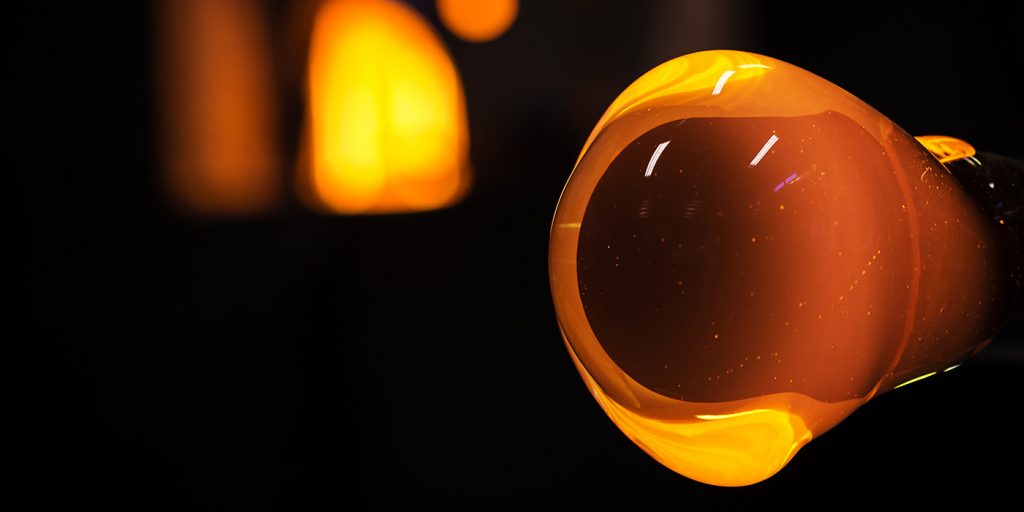
What is glass viscosity?
Viscosity is a measure of a liquid’s fluidity, and is measured through a substance’s resistance to motion under an applied force. It is also known as the thickness of a fluid. It is calculated by dividing shear stress (the force per unit area required to move one layer of fluid in relation to another) by shear rate (the measure of the change in speed at which intermediate layers move with respect to one another). The result is usually expressed in poise (P), the equivalent of 0.1 Pa∙s (pascal second).
Glass viscosity varies inversely with temperature. As it is heated, viscosity decreases and it flows more easily. This is because the thermal energy produced causes the structural molecules to move faster and break the bonds between those molecules. As the temperature decreases, viscosity increases, causing the structural bonds to re-form.
The relationship between temperature and viscosity is linked directly to the chemical composition of a glass. Manufacturers need techniques to measure and model this relationship for a range of glass compositions and temperatures. The viscosities of most commercial glasses like soda lime and borosilicate are measured between 800°C and 1400°C.
Why is glass viscosity important?
The visocisity of a glass significantly affects other physical properties, such as softening, melting and crystallization characteristics, as well as the temperature and pressure ranges within which the glass can be worked. Knowing the relationship between temperature and viscosity is key to determining the correct melting and heat treatment regimes in glass production and processing.
Manufacturers monitor temperature and viscosity throughout the manufacturing process in order to know how the glass will behave. For example, viscosity can directly affect refractory corrosion and the ability to homogenize a melt. It is important during the fining process to ensure the batch chemicals are properly melted and air bubbles are forced out. Additionally, a glass’s viscocity gives manuacturerses the ability to predict how the glass will perform in the glass forming process such as casting monolithic parts, spheroidization, or fiber generation.
Measuring viscosity
Most viscometers work by comparing a stationary object and a flowing fluid, or a moving object and a stationary fluid. They measure the drag resistance during this movement. There are a range of viscometers available.
Rotation viscometers are commonly used to measure the viscosity in the range of 1 to 104 Pa·s. They employ a platinum alloy spindle immersed in a crucible of molten glass. Spindle torque is measured and used to calculate viscosity. The crucible can either be stationary and the spindle rotates, or the crucible rotates and the spindle is stationary. Generally, data points are taken as a function of temperature to describe the viscosity curve for the glass.
Falling sphere viscometers can be used to measure the viscosity in the range of 1 to 106 Pa·s. They measure the time taken for a falling sphere of known density and radius to move between two points. This method employs principles from Stokes’s Law, which takes into account the drag force on a falling sphere.
Parallel plate viscometers measure the rate of change in thickness of a cylindrical specimen between parallel plates moving perpendicular to their common central axis. This method is often used to measure the viscosity in the range of 105 to 108 Pa·s.
Fiber elongation viscometers measure the elongation rate of a fiber of known dimensions under a known load. This method can be used for viscosities ranging from 105 to 1012 Pa·s and it is widely used to determine the Littleton softening and annealing reference points.
Transformation range viscosities (108 to 1013 Pa·s) are often measured by the beam-bending method. Beam-bending is a method in which the rate of viscous bending of a simply loaded glass beam is measured over an extend period of time.
Glass viscosity optimization from MO SCI
MO SCI has extensive experience optimizing glass compositions for viscosity and many other parameters to work within the constraints of your manufacturing process. Contact us today to discuss your next project.
References
- The Physics Hyper-Textbook, Viscosity https://physics.info/viscosity/
- The Glass Packaging Institute, Viscosity https://www.glass-ts.com/services/temperature-viscosity
- Glassglobal Consulting, Glass properties https://www.glassglobal.com/consulting/reports/glass/properties.asp:
- Bright Hub Engineering, Types of Viscosity Measurement Devices https://www.brighthubengineering.com/fluid-mechanics-hydraulics/83996-viscosity-measurement-equipment/
- ASTM C965 – 96(2017), Standard Practice for Measuring Viscosity of Glass Above the Softening Point https://www.astm.org/Standards/C965.htm
- Designation: C1351M − 96 (Reapproved 2012), Standard Test Method for Measurement of Viscosity of Glass Between 104 Pa·s and 108 Pa·s http://materialstandard.com/wp-content/uploads/2019/09/C1351M-96-Reapproved-2012.pdf
- ASTM C1350M – 96(2019), Standard Test Method for Measurement of Viscosity of Glass Between Softening Point and Annealing Range (Approximately 108 Pa·s to Approximately 1013 Pa·s) by Beam Bending, https://www.astm.org/Standards/C1350M.htm
